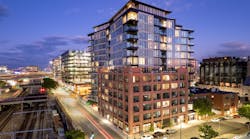Adaptive reuse—repurposing an existing structure and making it suitable for a new use—gives old buildings new purpose. It allows building owners to maintain the historic fabric of their communities while modernizing the building so it can function in the present day. Best of all, it’s a highly sustainable way to improve your portfolio.
“There are many benefits to adaptive reuse,” said Phil Renzi, associate at The Architectural Team. “Repurposing an old building and giving it new life as opposed to tearing it down and filling up a landfill is at the heart of sustainability.”
Reviving old buildings also presents opportunities to showcase building features that aren’t common anymore “in terms of size of fenestration, tall ceilings and in some cases exposing antiquated structural framing systems, such as groin vaults,” Renzi added.
That was certainly the case at Courthouse Lofts, an adaptive reuse project that transformed a landmark courthouse complex in Worcester, Massachusetts, into a 118-unit apartment community and on-site museum. The monumental, dome-ceilinged former primary courtroom now houses a central resident amenity space. The residential units, which range in size from studio to three-bedroom, are nearly all unique and marry historic detailing with modern functionality.
Courthouse Lofts architecturally integrates four interconnected structures that were built between 1845 and 1955, and the historic detailing reflects this, Renzi said: “You can have your friend over to your apartment in the 1955 edition and it’s completely different from their apartment in the 1898 portion of the building.”
Why Adaptive Reuse?
Building owners turn to adaptive reuse for many reasons. Sustainability is a key one, and adaptive reuse can also be highly cost-effective for some buildings, said David Block, director of development for Evergreen Real Estate Group.
“There is substantial embodied energy in an existing building, so if you demolish that building, you’re essentially destroying all that embodied energy,” Block said. “Whereas with an adaptive reuse project, you’re avoiding a lot of the energy sink and greenhouse gas emission components of that process. Provided that, you may have to make some compromises in the plan—it’s possible that the column spacing in an older building may be smaller than what you would want in a new building, but if you’re willing to make those sacrifices as an owner, it can be a very green and cost-effective way to build.”
The process carries other advantages too. Getting through the planning and zoning process can be easier because the structure is already built, Renzi said.
“If it’s an historic property, the building may be eligible for tax credits, which can be a great source of funds for the project to address facade renovation and restoration, fenestrations, etc.,” Renzi added. “Typically these funds are allocated for the repointing of masonry and stone surfaces, repair of those surfaces, new windows, new roof systems and cornice or corbel work. There’s a huge benefit there.”
The cost is typically on par with new construction, though historic buildings may occasionally require extra funds to preserve historic elements, Block noted. However, the effort is worth it to preserve older buildings and transform them into true jewels. Case in point: Aurora St. Charles Senior Living, a 60-unit affordable senior housing complex created from the former St. Charles Hospital in Aurora, Illinois. The award-winning redevelopment preserved many of the historic building’s original Art Deco features, including terrazzo and stone floors in common areas, oversized windows in each residence and 9-foot ceilings throughout the building. The Evergreen team also restored the exterior and renovated the front lobby with artful contemporary glass to fit with the Art Deco style.
Not all underutilized buildings are suitable for adaptive reuse, however. Architects look at many aspects of a building to determine if adaptive reuse is a viable strategy compared to demolition, including:
- Overall condition. “Oftentimes we’ll find in older buildings some level of neglect, but it may not be throughout. Perhaps the roof sustained some damage and there was water penetration, but only in a portion of the building,” Renzi said. “That can be relatively easily remedied. What’s key is the condition of the structure.” Exterior walls, typically load bearing in masonry structures, and the floor and roof framing systems should be in stable condition for adaptive reuse projects to succeed.
- Dimensions. Physical and dimensional characteristics are a crucial consideration for adaptive reuse, said Tom Schultz, associate at The Architectural Team.
- The planned use for the building. Once architects understand the structure’s layout and dimensions, they can determine whether the owner’s intended use for the building will work for the structure.
Dimensional considerations were key for 100 Shawmut, a Boston condominium community with 138 residential units and public open space. The former warehouse was about 100 feet square, more than the 60-70 feet that’s typical for residential communities. “We had to shave off a portion of it and also drop in a new core,” Schultz said. TAT also added a new “jewel box” addition above the building—a seven-story glass and terracotta addition that tops the existing six-story facility.
“The structural aspect was probably the biggest challenge, but the foundations really helped us,” Schultz said. “The concrete core goes up through everything and locks it together… The structural engineer did a great job of figuring out how to land that building and impact the addition as little as possible, and it allowed for those units to be laid out more effectively.”
Potential Pitfalls of Adaptive Reuse
If you’ve taken on an adaptive reuse project before, you know there can be surprises once you begin to open up the building. Mechanical systems may be in a different place than you were expecting, and window placements may not be ideal for your new use.
Historic buildings also come with an extra layer of difficulty when it comes to gathering needed approvals and qualifying for tax credits. The team working on Courthouse Lofts found that the National Park Service imposed specific requirements for each of the four connected structures built in different eras.
“We had to preserve a courtroom from each of the four eras,” Renzi explained. “The 1800s portions of the buildings had highly detailed ornamental trim and woodwork, while the midcentury modern 1955 portion is very sleek with clean lines. We had to treat the finishes within each of those different eras commensurate with that era, so in the 1955 edition we had flush wood panel doors and the 1800s buildings had eight-panel mahogany doors. Those types of things can come into play as far as complications go, but those are opportunities as well to create unique spaces you otherwise wouldn’t be able to create in new construction.”
Your adaptive reuse journey should start with an architect who’s experienced in this type of work, Renzi advises. A qualified architectural historian can be a key team player for historic buildings—they can verify whether your building qualifies for listing in the National Register of Historic Places and determine if it qualifies for historic tax credits.
“Be prepared for a serious project,” Block advised. “Adaptive reuse projects are not for the faint of heart. You’re taking the building apart almost down to the studs and putting it back together—it’s as demanding and as substantial a construction project as new construction, and you need to be prepared for that.”
Despite the inherent challenges, adaptive reuse can be a great solution to revitalize and rejuvenate older buildings, Renzi said: “If it’s a good building in good shape, has a floor plate that can be adapted to your client’s needs and has really good bones, why tear it down if you can find a new way to creatively repurpose it?”
x



